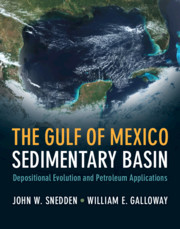Book contents
- The Gulf of Mexico Sedimentary Basin
- The Gulf of Mexico Sedimentary Basin
- Copyright page
- Dedication
- Contents
- Preface
- Abbreviations
- Part I Introduction
- Part II Mesozoic Depositional Evolution
- Chapter 2 Post-Orogenic Successor Basin-Fill and Rifting Phase
- Chapter 3 Middle Mesozoic Drift and Cooling Phase
- Chapter 4 Late Mesozoic Local Tectonic and Crustal Heating Phase
- Part III Cenozoic Depositional Evolution
- Part IV Petroleum Habitat
- Glossary
- References
- Index
Chapter 2 - Post-Orogenic Successor Basin-Fill and Rifting Phase
from Part II - Mesozoic Depositional Evolution
Published online by Cambridge University Press: 13 September 2019
- The Gulf of Mexico Sedimentary Basin
- The Gulf of Mexico Sedimentary Basin
- Copyright page
- Dedication
- Contents
- Preface
- Abbreviations
- Part I Introduction
- Part II Mesozoic Depositional Evolution
- Chapter 2 Post-Orogenic Successor Basin-Fill and Rifting Phase
- Chapter 3 Middle Mesozoic Drift and Cooling Phase
- Chapter 4 Late Mesozoic Local Tectonic and Crustal Heating Phase
- Part III Cenozoic Depositional Evolution
- Part IV Petroleum Habitat
- Glossary
- References
- Index
Summary
The Gulf of Mexico Mesozoic depositional history can be subdivided into a series of tectonostratigraphic phases, with the first phase covering sedimentation associated with post-Quachita–Marathon orogenic successor basin-fill and rifting. In this early Mesozoic timeframe, the basin precursor units called Eagle Mills (USA) and equivalents in Mexico were deposited, draining diverse Appalachian, pan-African, and other source terranes. The new tectonostratigraphic model is based upon updated plate tectonic reconstructions, detrital zircon geochronology from deep wells, and analysis of new seismic reflection data in Mexico and the USA. Newly developed concepts depart from conventional GoM thinking both in terms of timing and kinematics. Evidence suggests the South Georgia–Newark rift system does not extend into Texas–Louisiana and much of the Triassic Eagle Mills deposition here occurred in a successor basin overlying the deformed Quachita–Marathon system. Pre-salt deposition in northern Yucatan forms a seaward dipping wedge of younger (likely Early Jurassic) continental deposition derived from erosion of exposed Yucatán basement.
Keywords
- Type
- Chapter
- Information
- The Gulf of Mexico Sedimentary BasinDepositional Evolution and Petroleum Applications, pp. 54 - 64Publisher: Cambridge University PressPrint publication year: 2019

